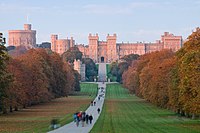|
"William Essex trained as an enamel painter in the workshop of Charles Muss (1779 – 1824), Enamel Painter to William IV. Essex first exhibited at the Royal Academy in 1818 and throughout the 1820s and early 1830s built up a successful practice, working chiefly in enamel. William Essex must have had his first introduction to court circles through Charles Muss. He may initially have worked in collaboration with his teacher, but by 1827 was earning his own commissions from George IV. In 1834 Essex painted an enamel miniature of Charlotte, Duchess of Northumberland, governess to Queen Victoria, after Sir Thomas Lawrence; although he was already well established in royal circles, his patronage by the Duchess of Northumberland may have been an additional factor that contributed to his appointment as Enamel Painter to Queen Victoria in 1837 and Enamel Painter to Prince Albert in 1841. Queen Victoria employed Essex to make numerous enamel copies of portraits of her after Franz Xaver Winterhalter, which were set into bracelets and distributed as gifts. He also made numerous copies of portraits of her relatives and contemporaries. Most of these were commissioned within the same year as the original on which they were based, and were often given by Queen Victoria to Prince Albert. He also made historical copies of early miniatures and portraits at Windsor. Despite Essex's ostensible success, however, he fell into poverty in his later years and was forced to request that the Queen supplement his artist's annuity of £40 with a pension.
Essex's enamel is after a pastel by Johann Heinrich Schröder (1757 – 1812), part of a set of the Duke of Saxe-Coburg-Saalfeld and his family, at Schloss Callenburg, Coburg. An oil copy was painted by Herbert Luther Smith in 1844 for Queen Victoria (406214), but Essex's copy clearly pre-dates this. Almost sixty years after his death, the Duke's fourth son, Leopold I, King of the Belgians, wrote to Queen Victoria: 'My poor father comparatively early in life suffering from poor health was the most amiable and humane character, benevolence itself … His great love and knowledge of everything connected with the fine arts, was inherited by Albert, no one else in the family possessed it to the same degree'
.
Francis, Duke of Saxe-Coburg-Saalfeld, eldest son of Ernest Frederick, Duke of Saxe-Coburg-Saalfeld, and Sophie, daughter of Ferdinand Albert II, Duke of Brunswick-Wolfenbüttel, married, in 1777, as his second wife, Augusta, daughter of Henry XXIV, Count Reuss-Ebersdorff. The seven children he had by her included Victoria, Duchess of Kent, and Ernest I, Duke of Saxe-Coburg-Gotha, through whom he was grandfather to Queen Victoria and to Prince Albert. Through his shrewd matchmaking, his children made marriages that secured the alliance of the Saxe-Coburg ducal family to many of the ruling houses of Europe in the mid-nineteenth century." [1]
| 



